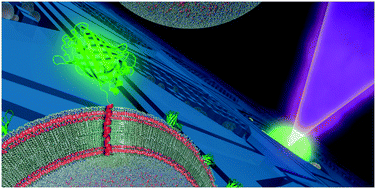The plasma membrane is a key component of living organisms and is essential to all life. It separates the inside of the cell from the outside, compartmentalizes reactions, and selectively allows transport across it. While a lot of research has gone into how different proteins and surface molecules control the functions of the plasma membrane, less is known about how lipid composition gives rise to specific properties. For instance, transmembrane proteins, which are also a large class of drug targets, may have different requirements for the lipid environment or may have their function modified depending on local lipid composition. Recently, researchers from the David Weitz Lab at Harvard, have developed a microfluidic chip which they used to screen the largest lipid library to date, in order to identify which lipid compositions have specificity for certain protein transmembrane domains. This allows researchers to investigate the effect of local lipid concentration on transmembrane proteins.
The plasma membrane is often described as a ‘simple barrier’. But if that’s the case, then “why does nature go through the trouble of making so many different types of lipids?” explained Roy Ziblat, the lead author on the paper. Ziblat believes that the lipid membrane role is far bigger than a mere barrier and it serves as a substrate for accelerating bio-reactions. The role of the lipids composing the membrane is to control which biomolecules participate in these reactions, by their selectivity to membrane proteins. Having limited success with existing techniques, Ziblat turned to microfluidics to try to answer this question.
The microfluidic chip comprises an array of 108 wells in PDMS where lipid films can be deposited and dried before sealing the chip with another layer of PDMS. Liposomes are generated within the wells by swelling in aqueous buffer. These liposomes are then tested to see whether or not transmembrane domain peptides will insert into them. However, because the transmembrane domain peptides are insoluble, they can’t simply be added into the chip. To get around this, Ziblat et al. turned to cell-free protein synthesis. By loading the chip with DNA for the transmembrane domain peptide and PURExpress (a commercial cocktail of ribosomes, enzymes, and nucleotides for transcription and translation), the peptides can be synthesized in close proximity to the liposomes, thus minimizing precipitation and increasing the chance of insertion. The paper by Ziblat et al., which was featured on the cover of the 7th December issue of Lab on a Chip, also includes a helpful video description of these methods. Ziblat said he first made the video to better communicate his methods with his supervisor and colleagues, but it really helps the reader understand a very technical methodology.
Going forward, Ziblat hopes to use the device to study other membrane interactions, such as virus-cell binding. There’s also hope that this new device and method can be used to identify what the authors call “druggable lipids”—peptides that interact with specific lipids and thus better direct drugs toward specific cells or even organelles.
To download the full article, click the link below:
Determining the lipid specificity of insoluble protein transmembrane domains
R. Ziblat, J. C. Weaver, L. R. Arriaga, S. Chong and D. A. Weitz
Lab Chip, 2018, 18, 3561
DOI: 10.1039/c8lc00311d
Darius Rackus (right) is a postdoctoral researcher in the Dittrich Bionalytics Group at ETH Zürich. His research interests are in developing integrated microfluidic tools for healthcare and bioanalysis












